Page 128 of 532
128 1-7. Safety information
URBAN CRUISER_EE (OM52C21E)
Conditions under which the SRS airbags may deploy (inflate), other
than a collision
The SRS front airbags may also deploy if a serious impact occurs to the
underside of your vehicle. Some examples are shown in the illustration.
Types of collisions that may not deploy the SRS airbag (SRS front air-
bags)
The SRS front airbags are generally not designed to inflate if the vehicle is
involved in a side or rear collision, if it rolls over, or if it is involved in a low-
speed frontal collision. But, whenever a collision of any type causes suffi-
cient forward deceleration of the vehicle, deployment of the SRS front air-
bags may occur.
Hitting a curb, edge of pavement or
hard surface
Falling into or jumping over a deep hole
Landing hard or vehicle falling
Collision from the side
Collision from the rear
Vehicle rollover
Page 174 of 532
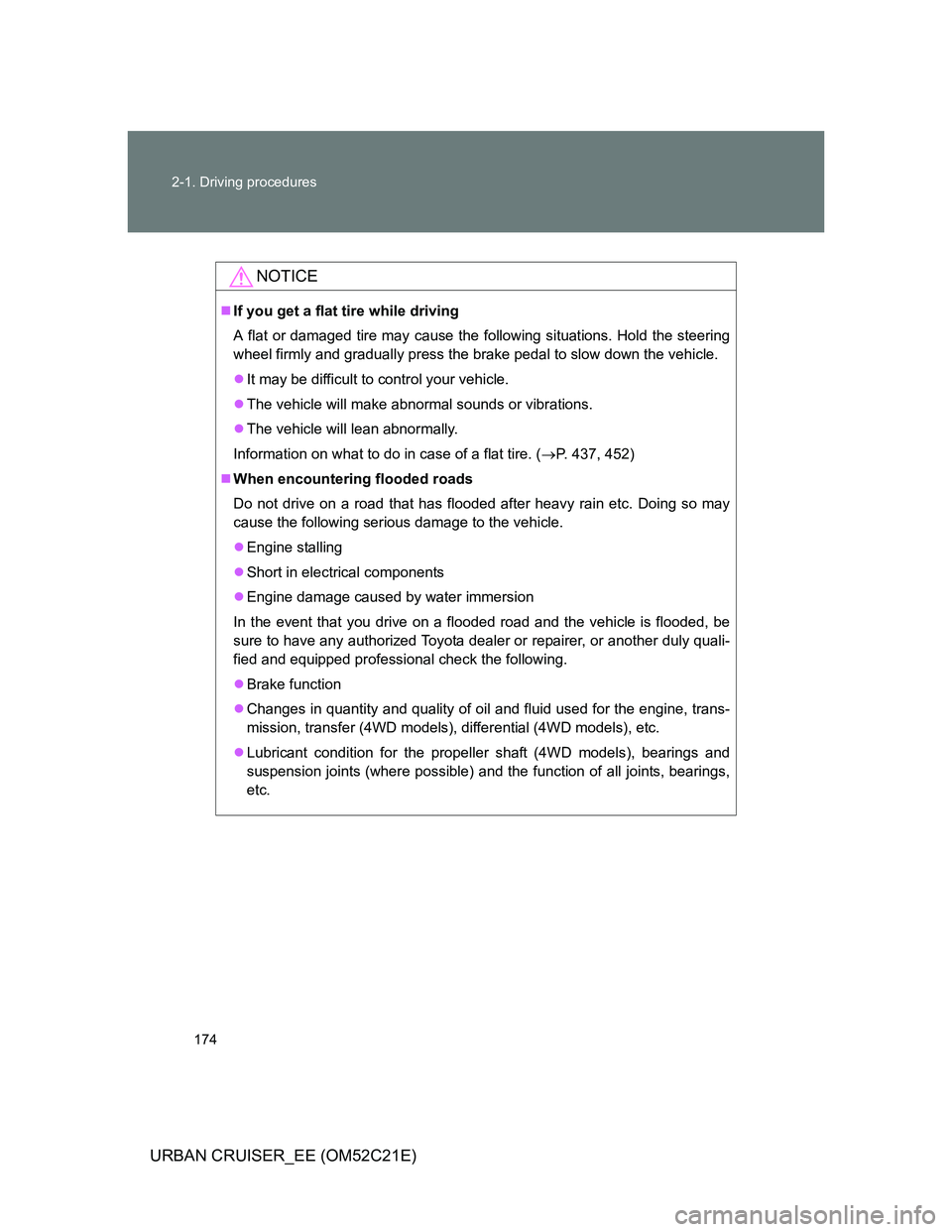
174 2-1. Driving procedures
URBAN CRUISER_EE (OM52C21E)
NOTICE
If you get a flat tire while driving
A flat or damaged tire may cause the following situations. Hold the steering
wheel firmly and gradually press the brake pedal to slow down the vehicle.
It may be difficult to control your vehicle.
The vehicle will make abnormal sounds or vibrations.
The vehicle will lean abnormally.
Information on what to do in case of a flat tire. (P. 437, 452)
When encountering flooded roads
Do not drive on a road that has flooded after heavy rain etc. Doing so may
cause the following serious damage to the vehicle.
Engine stalling
Short in electrical components
Engine damage caused by water immersion
In the event that you drive on a flooded road and the vehicle is flooded, be
sure to have any authorized Toyota dealer or repairer, or another duly quali-
fied and equipped professional check the following.
Brake function
Changes in quantity and quality of oil and fluid used for the engine, trans-
mission, transfer (4WD models), differential (4WD models), etc.
Lubricant condition for the propeller shaft (4WD models), bearings and
suspension joints (where possible) and the function of all joints, bearings,
etc.
Page 181 of 532
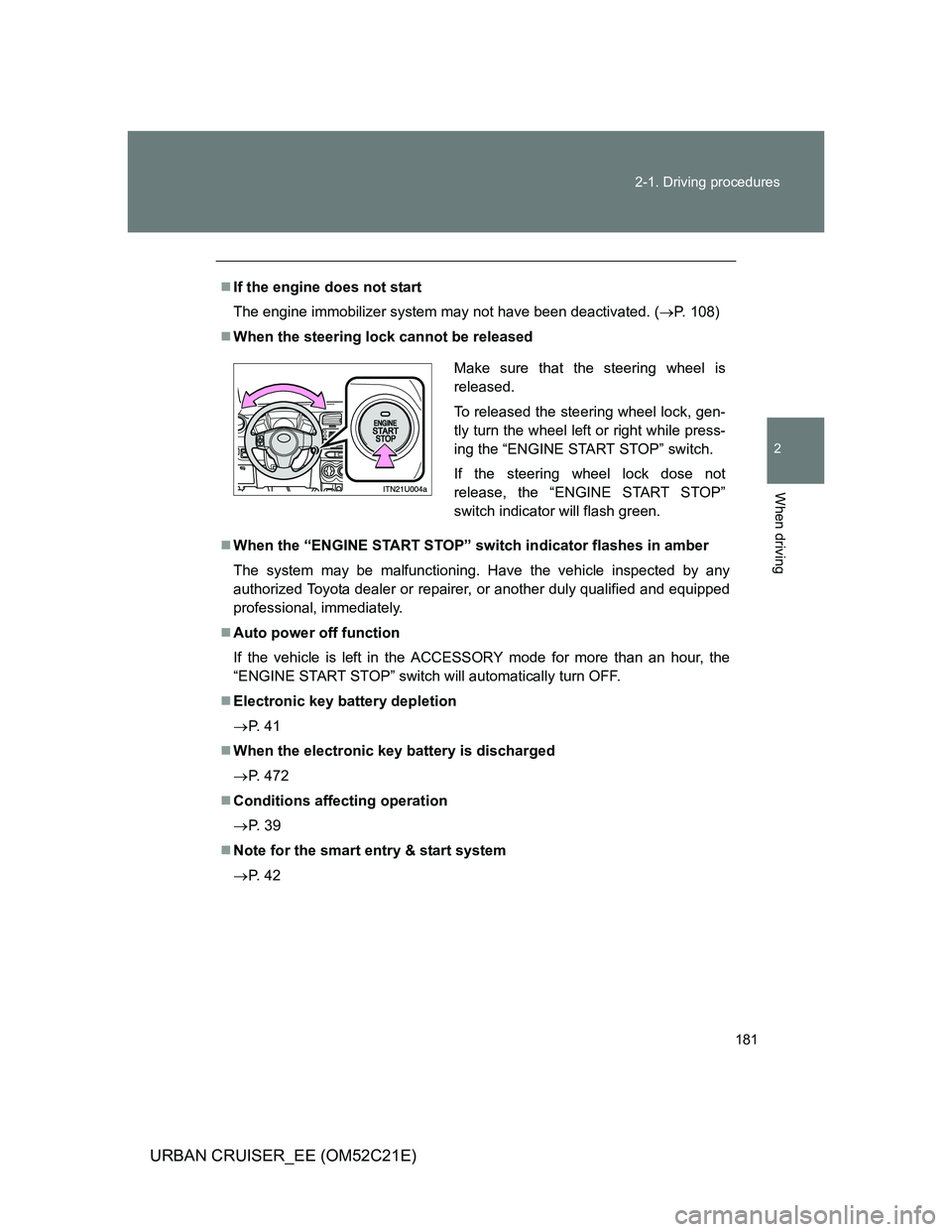
181 2-1. Driving procedures
2
When driving
URBAN CRUISER_EE (OM52C21E)
If the engine does not start
The engine immobilizer system may not have been deactivated. (P. 108)
When the steering lock cannot be released
When the “ENGINE START STOP” switch indicator flashes in amber
The system may be malfunctioning. Have the vehicle inspected by any
authorized Toyota dealer or repairer, or another duly qualified and equipped
professional, immediately.
Auto power off function
If the vehicle is left in the ACCESSORY mode for more than an hour, the
“ENGINE START STOP” switch will automatically turn OFF.
Electronic key battery depletion
P. 4 1
When the electronic key battery is discharged
P. 472
Conditions affecting operation
P. 3 9
Note for the smart entry & start system
P. 4 2
Make sure that the steering wheel is
released.
To released the steering wheel lock, gen-
tly turn the wheel left or right while press-
ing the “ENGINE START STOP” switch.
If the steering wheel lock dose not
release, the “ENGINE START STOP”
switch indicator will flash green.
Page 213 of 532
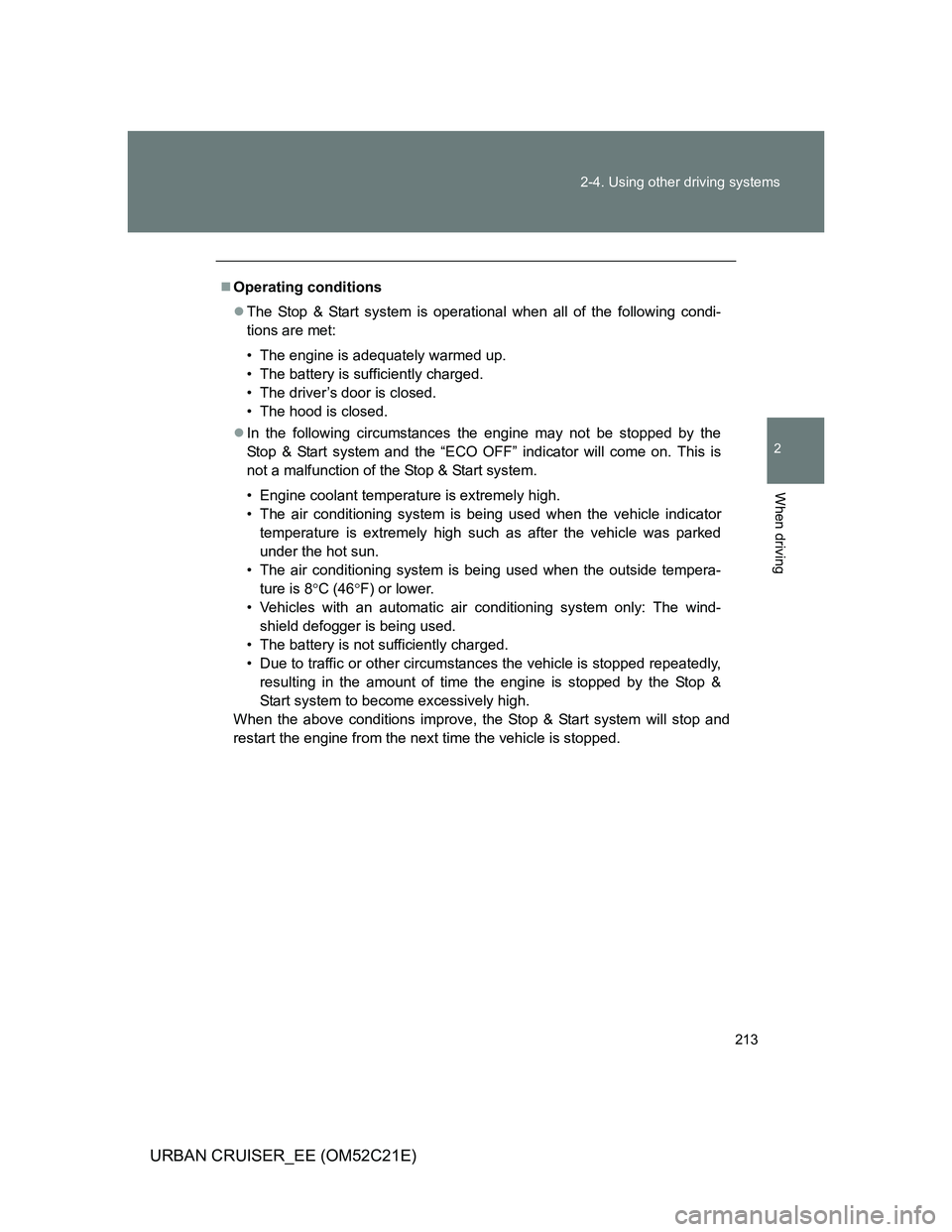
213 2-4. Using other driving systems
2
When driving
URBAN CRUISER_EE (OM52C21E)
Operating conditions
The Stop & Start system is operational when all of the following condi-
tions are met:
• The engine is adequately warmed up.
• The battery is sufficiently charged.
• The driver’s door is closed.
• The hood is closed.
In the following circumstances the engine may not be stopped by the
Stop & Start system and the “ECO OFF” indicator will come on. This is
not a malfunction of the Stop & Start system.
• Engine coolant temperature is extremely high.
• The air conditioning system is being used when the vehicle indicator
temperature is extremely high such as after the vehicle was parked
under the hot sun.
• The air conditioning system is being used when the outside tempera-
ture is 8C (46F) or lower.
• Vehicles with an automatic air conditioning system only: The wind-
shield defogger is being used.
• The battery is not sufficiently charged.
• Due to traffic or other circumstances the vehicle is stopped repeatedly,
resulting in the amount of time the engine is stopped by the Stop &
Start system to become excessively high.
When the above conditions improve, the Stop & Start system will stop and
restart the engine from the next time the vehicle is stopped.
Page 214 of 532
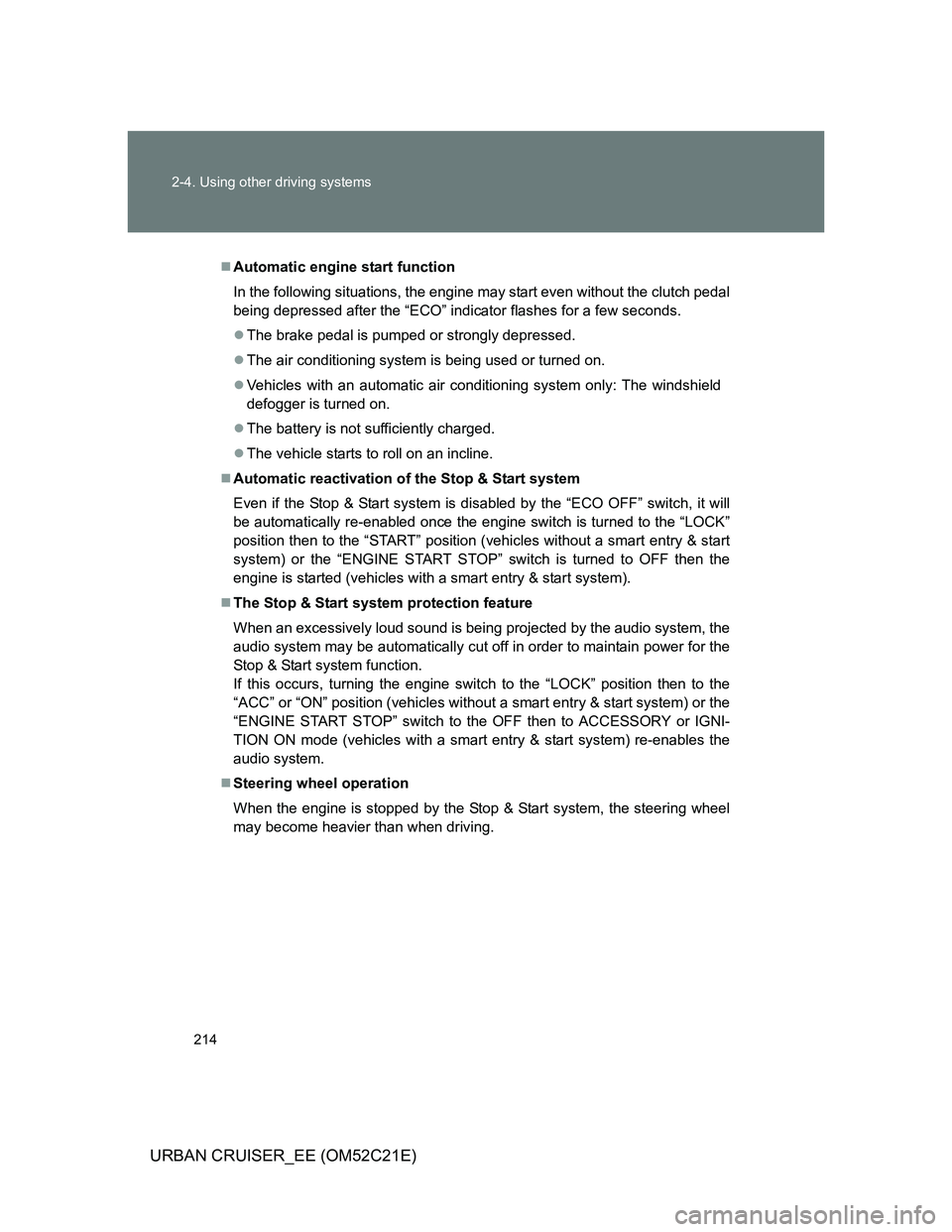
214 2-4. Using other driving systems
URBAN CRUISER_EE (OM52C21E)
Automatic engine start function
In the following situations, the engine may start even without the clutch pedal
being depressed after the “ECO” indicator flashes for a few seconds.
The brake pedal is pumped or strongly depressed.
The air conditioning system is being used or turned on.
Vehicles with an automatic air conditioning system only: The windshield
defogger is turned on.
The battery is not sufficiently charged.
The vehicle starts to roll on an incline.
Automatic reactivation of the Stop & Start system
Even if the Stop & Start system is disabled by the “ECO OFF” switch, it will
be automatically re-enabled once the engine switch is turned to the “LOCK”
position then to the “START” position (vehicles without a smart entry & start
system) or the “ENGINE START STOP” switch is turned to OFF then the
engine is started (vehicles with a smart entry & start system).
The Stop & Start system protection feature
When an excessively loud sound is being projected by the audio system, the
audio system may be automatically cut off in order to maintain power for the
Stop & Start system function.
If this occurs, turning the engine switch to the “LOCK” position then to the
“ACC” or “ON” position (vehicles without a smart entry & start system) or the
“ENGINE START STOP” switch to the OFF then to ACCESSORY or IGNI-
TION ON mode (vehicles with a smart entry & start system) re-enables the
audio system.
Steering wheel operation
When the engine is stopped by the Stop & Start system, the steering wheel
may become heavier than when driving.
Page 215 of 532
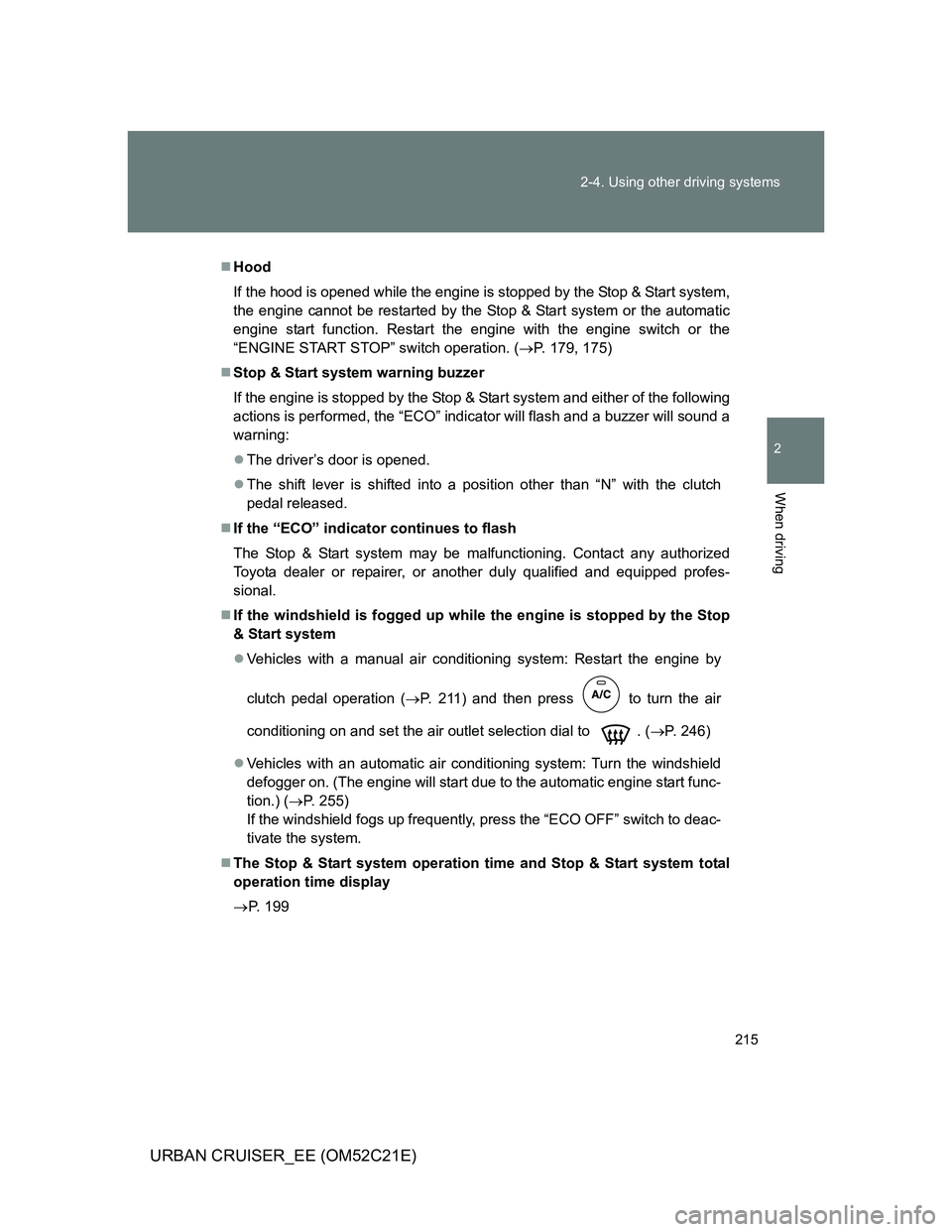
215 2-4. Using other driving systems
2
When driving
URBAN CRUISER_EE (OM52C21E)
Hood
If the hood is opened while the engine is stopped by the Stop & Start system,
the engine cannot be restarted by the Stop & Start system or the automatic
engine start function. Restart the engine with the engine switch or the
“ENGINE START STOP” switch operation. (P. 179, 175)
Stop & Start system warning buzzer
If the engine is stopped by the Stop & Start system and either of the following
actions is performed, the “ECO” indicator will flash and a buzzer will sound a
warning:
The driver’s door is opened.
The shift lever is shifted into a position other than “N” with the clutch
pedal released.
If the “ECO” indicator continues to flash
The Stop & Start system may be malfunctioning. Contact any authorized
Toyota dealer or repairer, or another duly qualified and equipped profes-
sional.
If the windshield is fogged up while the engine is stopped by the Stop
& Start system
Vehicles with a manual air conditioning system: Restart the engine by
clutch pedal operation (P. 211) and then press to turn the air
conditioning on and set the air outlet selection dial to . (P. 246)
Vehicles with an automatic air conditioning system: Turn the windshield
defogger on. (The engine will start due to the automatic engine start func-
tion.) (P. 255)
If the windshield fogs up frequently, press the “ECO OFF” switch to deac-
tivate the system.
The Stop & Start system operation time and Stop & Start system total
operation time display
P. 199
Page 228 of 532
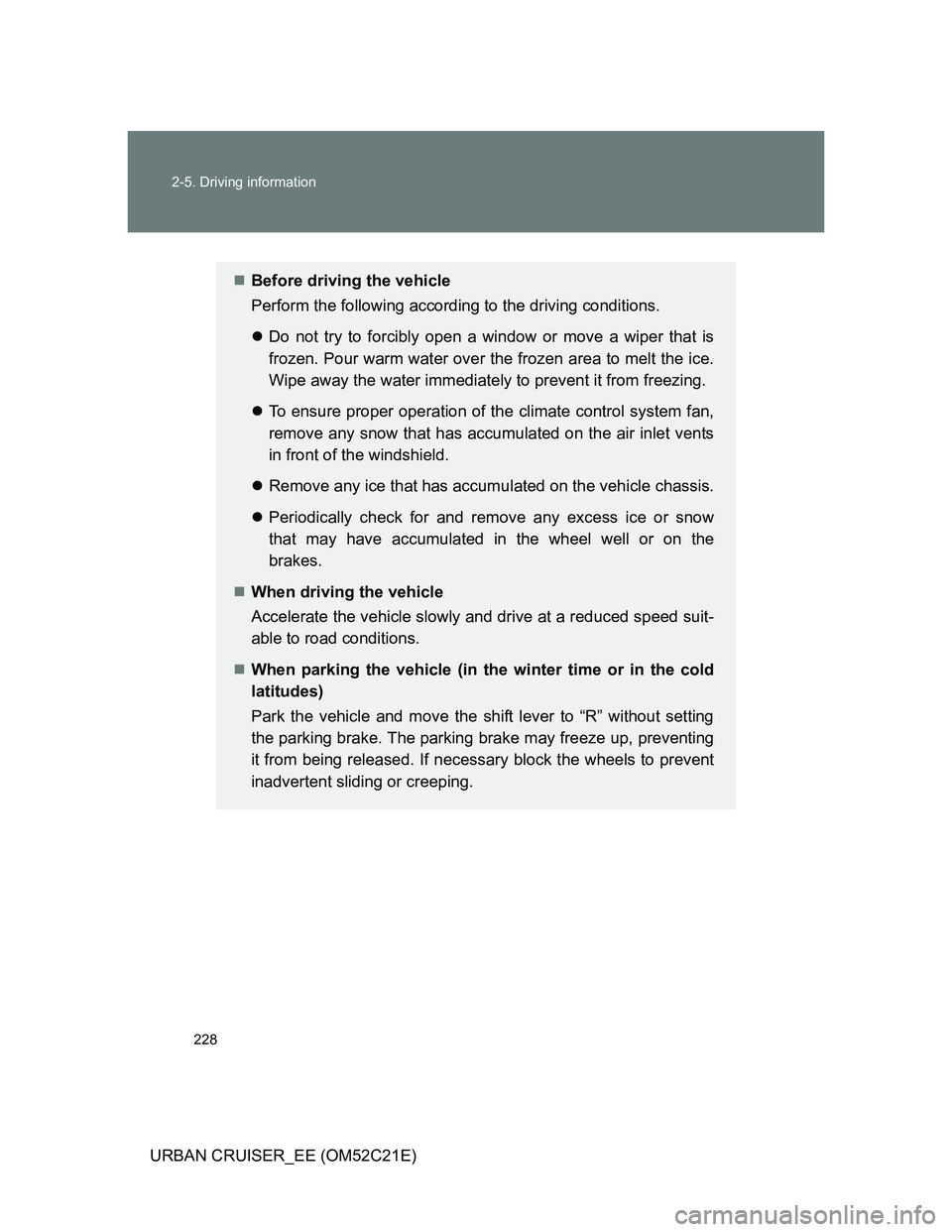
228 2-5. Driving information
URBAN CRUISER_EE (OM52C21E)
Before driving the vehicle
Perform the following according to the driving conditions.
Do not try to forcibly open a window or move a wiper that is
frozen. Pour warm water over the frozen area to melt the ice.
Wipe away the water immediately to prevent it from freezing.
To ensure proper operation of the climate control system fan,
remove any snow that has accumulated on the air inlet vents
in front of the windshield.
Remove any ice that has accumulated on the vehicle chassis.
Periodically check for and remove any excess ice or snow
that may have accumulated in the wheel well or on the
brakes.
When driving the vehicle
Accelerate the vehicle slowly and drive at a reduced speed suit-
able to road conditions.
When parking the vehicle (in the winter time or in the cold
latitudes)
Park the vehicle and move the shift lever to “R” without setting
the parking brake. The parking brake may freeze up, preventing
it from being released. If necessary block the wheels to prevent
inadvertent sliding or creeping.
Page 239 of 532
239 2-5. Driving information
2
When driving
URBAN CRUISER_EE (OM52C21E)Transmission information
To maintain engine braking efficiency, when using engine braking,
do not use the transmission in “6” gear. (P. 183)
If the engine overheats...
Towing a loaded trailer up a long steep incline in temperatures
exceeding 30C (85F) may result in the engine overheating. If the
engine coolant temperature gauge indicates that the engine is
overheating, turn the air conditioning off immediately, leave the
road and stop the vehicle in a safe place. (P. 481)
When parking the vehicle
Always place wheel chocks under the wheels of both the vehicle
and trailer. Firmly set the parking brake and shift the shift lever to
“1” or “R”.